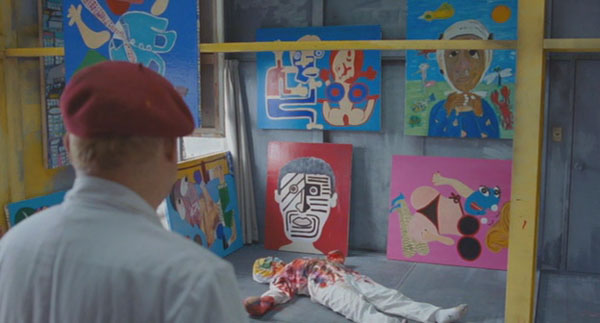The final film in one of the most enjoyable and satisfying trilogies of the decade, following the somewhat-rough Takeshis’ and the glorious Glory to the Filmmaker. Unfortunately, nobody else seems to enjoy these movies. When I searched online for info on this film, the most positive sentiments I could find were along the lines of “hooray, now that this nonsense is over, Kitano can get back to making movies worth watching.” And nobody I know personally will even watch them so discussion is nil… they are just my own private joy.

Totally different from the previous two, this one tells a linear story about a single character, Machisu, a painter. Constants in his life are a complete lack of critical or financial success, and people in his life dying (usually of head trauma), all of which Machisu tolerates silently with an impassive expression. Very self-deprecating (portrait of the director as a lifelong failed artist, a slack employee, a bad father), but I see some value in Machisu’s persistence, his single-minded refusal to stop painting, even the persistence in his suicide attempts at the end, which he finally combines with his painting. Maybe the movie was trying to show that this persistence is stupid, ridiculous, but I’m gonna read it my own way.

Starts out sometime post-WWII, maybe the 50’s, classically shot with your standard orchestral movie score, with Machisu the grade-school son of a rich banker father (Ren Osugi of MPD Psycho, Charisma, Fireworks) and his younger wife (Kanako Higuchi). Everyone from the parents to the teachers to the bus drivers indulges the boy’s painting whim and let him do what he likes. Bank crisis leads dad and mom to kill themselves (separately) and Machisu is shipped off to uncle Akira Nakao (of a buncha Godzilla movies) and aunt Mariko Tsutsui (of One Missed Call). Now uncle wants him to do housework, teachers want him to pay attention in class, and bus drivers won’t stop and let him paint them (as he’s leaving town, a bus kills a fellow painter, Machisu’s only friend).

Years later, Machisu is older and working at a newspaper press – now played by Yûrei Yanagi (of the Ju-on and Ring movies, but probably cast because he starred in Boiling Point, Takeshi’s first film as sole writer/director). Not sure how old he’s supposed to be – I’d assumed 20’s, but the actor is in his mid-40’s. Anyway, at his art dealer’s suggestion (he takes all his art dealer’s suggestions), he starts attending art school. He also hangs out with a group of over-enthusiastic classmates who try outrageous art projects, and dates a co-worker at the paper plant (Kumiko Aso, lead girl in Pulse). Two classmates die – one in a painting-by-car-crash experiment and one from suicide – and another goes on to fame (called “the Japanese Basquiat”, leading Machisu to study and imitate Basquiat). Machisu’s work is all imitation. He copies the styles of every artist he studies, one at a time, and if he manages to get a compliment on a painting he makes a pile of similar paintings. The dealer assures him none of this is worthwhile, and Machisu’s apartment becomes cluttered with his failed work. Meanwhile, some of his childhood paintings show up around town, sold by the dealer to gullible rich men as the work of unknown foreign master painters. It’s all a funnier and less shrill takedown of the art world than Art School Confidential.


In the third section, Machisu is finally played by our man Kitano, married with a daughter. His wife is an accomplice in his art projects, but the daughter is deathly embarrassed, finally leaves home and becomes a prostitute. People in general seem to have less patience for Machisu and his painting than ever before, and after the daughter’s death, his wife leaves him and Machisu attempts suicide – first by monoxide poisoning, then by sitting and painting in a wooden shack which he has set aflame. Rescued and bandaged from head to toe, he tries “found” art, picking a can off the street and trying to sell it until his wife comes by and picks him up.


The hundreds of paintings are by Kitano himself, which seems pretty monumental, even if they’re all supposed to be bad art. A cartoon intro (which explains the title) sets us up for disappointment, our hero never catching up with success because he’s always chasing it instead of setting his own path. The humor is dark when there is any. I think it’s a wonderful ending… just the sappy standard “walking into the sunset with girl on your arm” ending, but it’s a deserved bit of uplift after the last 15 minutes of failure and death that came before.

Kitano: “After my last two films, I’m approaching this one more seriously. Sometimes I want to make movies that pack audiences in.”

Recommended listening: Art Class by Superchunk